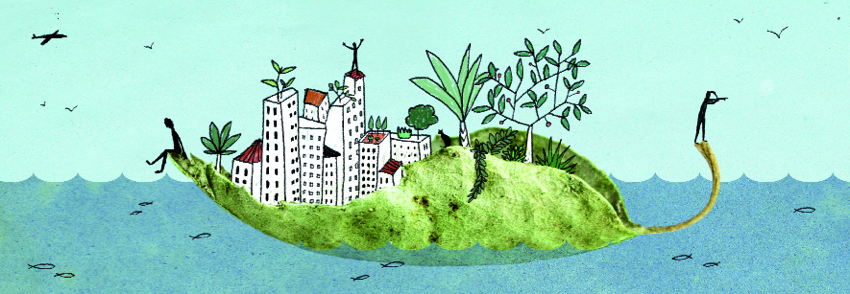There is a huge number of challenges to peace that the world will have to tackle in coming years. They will primarily have socio-economic and environmental origins.
The fact that we live in a world that is more peaceful, more prosperous and more developed technologically than the one our grandparents lived in is evidence shared by the majority of the planet. In this sense, there are numerous indicators that make it possible to interpret recent decades in an optimistic way. Proof of this is that the number of casualties in military conflict has fallen; economic development and life expectancy indicators have improved, as well as those for infant mortality and extreme poverty1. Moreover, the advance of technology seems unstoppable. We talk about the digital revolution, automation, the rise of artificial intelligence, new clean and cheap energy sources, 3D printers, Big Data applied to medical research and smart city management. We could go on.
However, the number of challenges that the world will have to tackle in coming years is likewise enormous. For years, authors from various disciplines and geographical origins have been highlighting the unequal distribution of hope in the world and the mood with which we face these challenges. Optimistic: people from India, China and a significant portion of Asia. Critical and increasingly frightened: people from the Western world and, especially, Europeans. Frustration and despair are concepts that apply to a good part of the Middle East, torn by tribal and religious struggles and by concealed economic interests. These concepts also apply to a significant portion of Central America that is being hit by violence. As for the rest: South America continues, heart in mouth, to await jolts from its economic dependence on the Chinese economy and the US dollar. Africa, finally, with immediate indicators (HIV/AIDS, corruption, human development, malaria, poverty), continues to be the black hole of global hope.
A few years ago in an article in Foreign Affairs2, Joseph Nye explained the reconfiguration of global power into three different spheres. The world will foreseeably continue to be unipolar from the military perspective. There is no military capability like that of the United States3. The planet’s military spending and the bulk of the most advanced military technology is found in this country. Economically, the world is now multipolar: the USA and EU are persistent economically; countries like China and India are emerging strongly, but with growing internal, social and environmental tensions. In terms of economic transactions, we live in an increasingly apolar world: companies of different nationalities take over from one another at an increasing pace. New sectors are created and others disappear.
The West receives these changes with concern for three main reasons. Firstly, because the global manufacturing governance model produced in 1945 by the West (the United Nations, the IMF, the World Bank, the World Trade Organisation (formerly GATT)) is teetering given the lack of legitimacy in reflecting a world and a division of powers that no longer tallies with the rise of the new emerging powers. Secondly, due to the jihadist threat to the West, which is marginal if we compare it to what is happening in other parts of the world, but very much present in the political discourse on immigration and refugees that is stirring up right-wing populism, anti-globalisation and anti-federal movements, against Washington in USA and Brussels in Europe. Finally, due to the current institutional weakness of the two superpowers: the USA and again with more intensity the EU, curbed by the lack of strong leadership, the weakness of the heterodox discourse in economic and social policy and the lack of overall public confidence towards political parties seen as corrupt or inefficient to deal with the magnitude of the challenges surrounding us.
The material root of global challenges
The main challenges to global peace will thus come from the complex web formed by the new global socio-economic challenges and the foreseeable consequences that climate change and the human footprint are leaving on the biosphere. On the surface of the problem is the techno-economic and social sphere. At the heart, the precarious health of the planet: the melting of the poles, biological ecosystems in decline, the disappearance of entire animal species, deforestation and deterioration of the soil and seabed, increasing global temperatures, lack of drinking water and the first displacements of populations facing rising sea levels (data from the World Bank, April 2016. High and Dry. Climate Change, Water and the Economy).
While globalisation since the end of the Cold War has entailed rapprochement between countries, cultures and consumption patterns, at global level it has also generated a backlash against the Western economic globalisation model, which in recent years has come to be superimposed over an increasingly negative interpretation of the impact of globalisation. This perception is extended and spread by the growing presence of global communication platforms, the internet and mobile telephony in our lives. The data illustrate this. Although the economic growth of recent decades has been distributed among countries and continents, moving from the West to Asia, Latin America and broad swathes of the African continent, it is also true that this has been uneven growth and that it has been accompanied by an increase in income differences within the various countries.4
The arrival of the so-called Fourth Industrial Revolution and the increase of the digital economy, robotization and automation of supply chains is aggravating these tensions today. In the short term, we are thinking about South-east Asia, about countries that have taken specialising in areas of low-added-value production and intensive, cheap labour as their model of industrialisation. The West is not on the sidelines of this discussion. We thus live in an increasingly connected and increasingly unequal world. A muddle in which comparison, discontent and resentment are generated, turning into a breeding ground for politics of hate and emotions.
With the growing urbanisation of the planet and the increase in the number of macro cities, particularly in Africa, resulting from the spatial reorganisation of territories under the pressure of economic interests and competition for natural resources, tensions are worsening. Current examples of these tensions would be the South China Sea and a significant part of Sub-Saharan Africa. A context in which new migratory pressures towards the north will foreseeably develop, as well as possible new local conflicts.
The counterpoint to these fragmenting trends can only be reached by strengthening new institutional and cooperative mechanisms that will allow us to progress towards an inclusive economic model that includes the sustainability of the planet. Only based on the counterweight of global co-responsibility, interdependence and solidarity will we be able to face the challenges clouding our collective future.
Note
1. Deaton A. (2013). The Great Escape: Health, Wealth and the Origins of Inequality. Princeton University.
2. Nye, J. (2010): “The Future of American Power. Dominance and Decline in Perspective”. Foreign Affairs.
3. www.sipri.org/databases/milex.
4. See The Economist, “Household income inequality: ladders to climb”. 29 April 2016. For Europe, the figures are found in McKinsey Global Institute (2016). Poorer than their parents? Flat or falling incomes in advanced economies. July.




